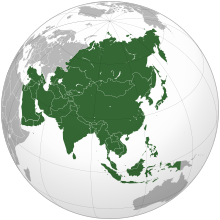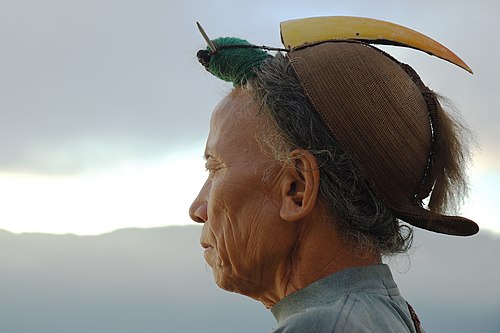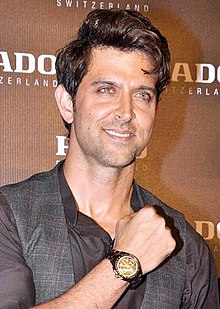Portal:Asia

 Asia (/ˈeɪʒə/ AY-zhə, UK also /ˈeɪʃə/ AY-shə) is the largest continent in the world by both land area and population. It covers an area of more than 44 million square kilometers, about 30% of Earth's total land area and 8% of Earth's total surface area. The continent, which has long been home to the majority of the human population, was the site of many of the first civilizations. Its 4.7 billion people constitute roughly 60% of the world's population. Asia shares the landmass of Eurasia with Europe, and of Afro-Eurasia with both Europe and Africa. In general terms, it is bounded on the east by the Pacific Ocean, on the south by the Indian Ocean, and on the north by the Arctic Ocean. The border of Asia with Europe is a historical and cultural construct, as there is no clear physical and geographical separation between them. It is somewhat arbitrary and has moved since its first conception in classical antiquity. The division of Eurasia into two continents reflects East–West cultural, linguistic, and ethnic differences, some of which vary on a spectrum rather than with a sharp dividing line. A commonly accepted division places Asia to the east of the Suez Canal separating it from Africa; and to the east of the Turkish Straits, the Ural Mountains and Ural River, and to the south of the Caucasus Mountains and the Caspian and Black seas, separating it from Europe. China and India traded places as the largest economies in the world from 1 to 1800 CE. China was a major economic power for much of recorded history, with the highest GDP per capita until 1500. The Silk Road became the main east–west trading route in the Asian hinterlands while the Straits of Malacca stood as a major sea route. Asia has exhibited economic dynamism as well as robust population growth during the 20th century, but overall population growth has since fallen. Asia was the birthplace of most of the world's mainstream religions including Hinduism, Zoroastrianism, Judaism, Jainism, Buddhism, Confucianism, Taoism, Christianity, Islam, Sikhism, as well as many other religions. (Full article...) Featured articleThe 1740 Batavia massacre (Dutch: Chinezenmoord, lit. 'Murder of the Chinese'; Indonesian: Geger Pacinan, lit. 'Chinatown tumult') was a massacre and pogrom in which European soldiers of the Dutch East India Company killed ethnic Chinese residents of the port city of Batavia, Dutch East Indies, (present-day Jakarta) in the Dutch East Indies. The violence in the city lasted from 9 October 1740, until 22 October, with minor skirmishes outside the walls continuing late into November that year. Historians have estimated that at least 10,000 ethnic Chinese were massacred; just 600 to 3,000 are believed to have survived. In September 1740, as unrest rose among the Chinese population, spurred by government repression and declining sugar prices, Governor-General Adriaan Valckenier declared that any uprising would be met with deadly force. On 7 October, hundreds of ethnic Chinese, many of them sugar mill workers, killed 50 Dutch soldiers, leading Dutch troops to confiscate all weapons from the Chinese populace and to place the Chinese under a curfew. Two days later, rumors of Chinese atrocities led other Batavian ethnic groups to burn Chinese houses along Besar River and Dutch soldiers to fire cannons at Chinese homes in revenge. The violence soon spread throughout Batavia, killing more Chinese. Although Valckenier declared an amnesty on 11 October, gangs of irregulars continued to hunt down and kill Chinese until 22 October, when the governor-general called more forcefully for a cessation of hostilities. Outside the city walls, clashes continued between Dutch troops and rioting sugar mill workers. After several weeks of minor skirmishes, Dutch-led troops assaulted Chinese strongholds in sugar mills throughout the area. (Full article...)Selected Country Azerbaijan, officially the Republic of Azerbaijan, is a transcontinental country located at the boundary of Eastern Europe and West Asia. It is a part of the South Caucasus region and is bounded by the Caspian Sea to the east, Russia's republic of Dagestan to the north, Georgia to the northwest, Armenia and Turkey to the west, and Iran to the south. Baku is the capital and largest city. The territory of what is now Azerbaijan was first ruled by Caucasian Albania and later various Persian empires. Until the 19th century, it remained part of Qajar Iran, but the Russo-Persian wars of 1804–1813 and 1826–1828 forced the Qajar Empire to cede its Caucasian territories to the Russian Empire; the treaties of Gulistan in 1813 and Turkmenchay in 1828 defined the border between Russia and Iran. The region north of the Aras was part of Iran until it was conquered by Russia in the 19th century, where it was administered as part of the Caucasus Viceroyalty. (Full article...)
Featured biographyHrithik Roshan (pronounced [ɾɪt̪ɪk ɾoʃən]; born 10 January 1974) is an Indian actor who works in Hindi cinema. He has portrayed a variety of characters and is known for his dancing skills. One of the highest-paid actors in India, he has won many awards, including six Filmfare Awards, of which four were for Best Actor. Starting from 2012, he has appeared in Forbes India's Celebrity 100 several times based on his income and popularity. Roshan has frequently collaborated with his father, Rakesh Roshan. He made brief appearances as a child actor in several films in the 1980s and later worked as an assistant director on four of his father's films. His first leading role was in the box-office success Kaho Naa... Pyaar Hai (2000), for which he received several awards. Performances in the 2000 terrorism drama Fiza and the 2001 ensemble family drama Kabhi Khushi Kabhie Gham... consolidated his reputation but were followed by several poorly received films. (Full article...)General imagesThe following are images from various Asia-related articles on Wikipedia. Featured picture Credit: Doniv79 The Nisi people principally inhabit the Indian state of Arunachal Pradesh.They inhabit the Papum Pare, East Kameng and Lower Subansiri, Kurung Kumey, parts of upper Subansiri districts of Arunachal Pradesh, as well as the Darrang District and North Lakhimpur district of Assam.
Did you know...
Updated: 6:33, 14 February 2024 In the news
Related portalsMajor Religions in Asia Middle East Central Asia and Surroundings Indian Subcontinent Southeast Asia East Asia Selected panorama
The night skyline of Hong Kong, Victoria Harbour and Kowloon, as seen from Victoria Peak, the tallest mountain on Hong Kong Island. Hong Kong is located on China's south coast on the Pearl River Delta, and borders Guangdong province in the north and faces the South China Sea in the east, west and south. It has a population of 6.9 million people, and is one of the most densely populated areas in the world. TopicsCategoriesAssociated WikimediaThe following Wikimedia Foundation sister projects provide more on this subject:
More portalsShortcuts to this page: Asia portal • P:ASIA Purge server cache |






























































































